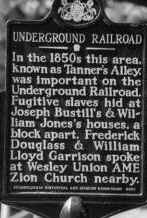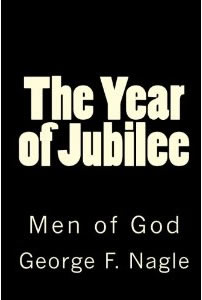
Study Areas
Junius C. Morel's "New Experiment" in Harrisburg
1835: Organized Anti-Slavery Activism
The following article is condensed from chapter 7 of The Year of Jubilee.
In the 1830s, the African American community of Harrisburg was undergoing significant changes. The most obvious of these was the size of the community, which increased from one hundred and seventy-seven individuals, in 1820, to four hundred and ninety-three individuals, as measured in the 1830 census. The African American tenant houses and rented rooms were bursting with new arrivals as more and more people streamed into this river town. Making up this swelling influx of new citizens were several distinct groups of people, the largest of which were free African Americans from the surrounding countryside. By 1830, Harrisburg housed more than half of the entire African American population of Dauphin County, as more and more Blacks migrated from township farms to Harrisburg's cramped urban neighborhoods.
Joining these county transplants were free African Americans from Maryland, Virginia, and Delaware, many of whom were fleeing to the interior of Pennsylvania to escape the stifling social structures that kept them in near slavery conditions in their home states. Mixing in with all these newcomers, and attempting to remain as unobtrusive and unnoticed as possible, were a number of self-liberated people, seeking the same fortune and opportunities as their free-born and newly manumitted brethren.
All of these newcomers created a furious mix of changing neighborhoods, frightening visits from slave hunters in search of the self-emancipated, and mounting racial tensions with borough whites uncomfortable with so many new dark-skinned faces. It was into this social and political turbulence that Caroline Richards and her erudite husband, Junius C. Morel moved from Philadelphia, in the summer of 1835. Junius Morel was a man already highly esteemed in Philadelphia's free African American community, and a voice of unwavering strength and resolution in defense of African American rights. He came to prominence as one of the organizers of the nations' first convention of African Americans, held at Mother Bethel church in Philadelphia, in September 1830, to address the questions of how to respond to the plight of African Americans in Ohio who were being forced out of that state by the reinstatement of black Codes. Because resettlement in the British province of Upper Canada was a possible solution for the Ohioans, the entire issue of emigration to escape forced colonization was to be addressed by the delegates.
Morel, who had escaped enslavement in North Carolina, was a dedicated proponent of emigration to Canada in situations where African American rights were trampled upon and people were systemically persecuted by the state. He worked at organizing the convention with Bishop Richard Allen, co-founder, along with Absalom Jones, of the Free African Society of Philadelphia, the nations' first African American mutual aid society, and founder of Bethel African Methodist Episcopal Church, in that city.
Bishop Allen controlled the first convention and directed the agenda, but he did not live to see the next annual convention, which was also held in Philadelphia. In his absence, the Philadelphia delegates scrambled for control of the conventions, with competing views on how best to oppose the building impetus of the colonization movement. The conventions eventually evolved into calls for African American moral reform, to center on "education, temperance and economy" as the means by which free African Americans would convince white Americans that they were morally fit to remain in the United States, rather than face forced emigration.
Although Junius Morel continued to espouse support for the Canadian emigrants, he did so because he saw in the Canadian settlements the chance for blacks to own land and shape their own destinies. To that end, he differed with those who supported moral improvement by free Blacks as the sole means of controlling their futures. Both of these strategies stood in unanimous opposition to the aims of the American Colonization Society, which sought to remove free African Americans from the United States and re-settle them in its colony in Liberia. By 1835 the moral reformers, sparked by groundwork laid the year before by Carlisle delegate John Peck, had gained the upper hand in the convention movement, and Junius Morel signaled his dissatisfaction with their aims by relocating to Harrisburg, from where he continued to put forth his ideas through letters published in the abolitionist newspaper the Colored American.35
Junius Morel's reasons for relocating to Harrisburg are not definitely known. He wrote in 1838 of his earlier efforts, while in Philadelphia, to guarantee the right of suffrage for African Americans through a strong political campaign, "But a vain temerity on the part of some, and a suicidal apathy on the part of others, prostrated my designs at that period."36 It is entirely possible that, knowing that the issue of African American voting rights was likely to be debated in the next state constitutional convention, Morel decided to move closer to the state capital, in order to better agitate on behalf of retaining the franchise.
The question of whether Pennsylvania should hold a convention to propose amendments to the state constitution was on the November 1835 ballot, just months after Junius and Caroline Morel moved to Harrisburg. Proposed constitutional changes restricting the African American franchise were advocated by reformers in Pennsylvania state politics who had gained power when Andrew Jackson won the state ten years earlier. These "reformers" were openly hostile toward abolition and African American rights. In that regard, it is probable that Morel, seeing the political climate in Pennsylvania swinging decidedly away from a continuing progression of African American rights, and feeling burned by earlier experiences in Philadelphia, decided to "go for the new experiment," in Harrisburg.
By the time that Junius Morel brought his "new experiment" to Harrisburg, the anti-slavery sentiment had been simmering for a few years, but had not yet taken on a public persona. Activities were confined to highly secretive and risky behavior, such as the aiding of fugitive slaves, and private discussions among the town's few abolitionists. Social acceptance of abolition among the white population was non-existent, and those whites who advocated for the slave found little sympathy among their neighbors. One important exception was the Rutherford family, whose estates spread across many acres of rich farmland in the outlying townships.
When family patriarch William Rutherford, Sr. began sheltering fugitive slaves who showed up at his Swatara Township farm, possibly as early as 1820, he was able to deflect the disapproval of his neighbors by virtue of his already well-established reputation for moral and religious vigor. His father had been a local hero of the Revolution, and William Rutherford himself served in the military during the War of 1812, ultimately attaining the rank of colonel. He entered politics and served terms as a state representative from 1810 to 1821, and from 1829-1831. Historian William Henry Egle described him as "one of the most influential men of his day in the county of Dauphin."
William educated his children well, and they entered the legal, medical, printing, and political professions, all while maintaining substantial and successful farms to the east of Harrisburg. All of William Rutherford's children seem to have embraced anti-slavery to some extent. Many of them offered shelter and aid to fugitive slaves on their farms, which extended from a few miles outside of Harrisburg along the newly laid turnpike road, to the heights of Chambers Hill. Those farms formed the early nucleus of Harrisburg's rural Underground Railroad route, which, in 1830, was still largely undeveloped and very haphazard in its operation. With the arrival of Junius Morel in Harrisburg, that early operation, along with all of Harrisburg's organized anti-slavery activities, was about to undergo a dramatic change.
Charles B. Ray Visits
In the summer of 1839, the multitalented publisher, abolitionist, and minister, Charles Bennett Ray, visited his "learned friend Morel" in Harrisburg. In a letter to his partner, co-owner of the abolitionist newspaper Colored American, Phillip A. Bell, Ray noted that Harrisburg "suits my notion better than any I had seen since my leaving Philadelphia." During a stroll through town, Ray and Junius Morel decided to visit the Capitol, intent upon obtaining the ear of some state legislators, but found it closed and vacant, the lawmakers having deserted town for cooler locales. So instead, the abolitionist publisher turned his attention to arranging a series of meetings with local African American citizens in the hopes of obtaining subscribers to his newspaper, which was perpetually in need of funding. He was optimistic of success, having previously described Harrisburg's Black citizenry as quite unlike the people in most other places; they exhibited a very intelligent look, and a cheerful countenance, indications of a better heart. Morel helped to arrange meetings on two successive nights, at which Ray could preach, lecture, and make appeals for subscribers. The activist minister, however, was sorely disappointed, securing but ten subscribers among a population of some hundreds from his public appeals in town. Ray expressed his dismay to Bell, asking:
How is this? The same reason which apply to our people in this state, more than in any other, in which I have traveled. A want of interest among the more intelligent, in the Abolition cause; for in almost exact proportion, as you find them engaged in this, you find them interested in the moral elevation of our people, and in the success of the Colored American. There are however a few choice spirits here and most of them either had, or did subscribe for the paper. I found a few very choice white abolitionists, some of whom rendered the paper some assistance.
Among the few choice spirits, Ray would have counted Junius Morel and a few of his neighbors, some of whom already received the Colored American. The failure of Ray to convince more of Harrisburg s African American residents to buy subscriptions to his newspaper, however, does not rule out an interest, as he concluded, in abolition. It more probably speaks to the severe lack of wealth among these residents, who only a few months before, had pooled their money to purchase a lot from the Forster estate, at the corner of Tanner Alley and South Street, and were in the process of erecting a new building to house the growing Wesley A.M.E. Church. They had outgrown the small log building at Third and Mulberry, and, once again under the visionary leadership of founding pastor David Stevens, they saw a new opportunity in the growth of the African American community on the narrow streets east of the Capitol building.
But money, as always, was tight, and the new building project had undoubtedly sapped their savings. The previous minister, Jacob D. Richardson, had begun his school for African American children in part to supplement his meager pay. Even Junius Morel, who championed support for the abolitionist newspapers, was frequently too cash-poor to afford a subscription.
Morel's more lasting and important contribution, however, was in introducing Ray and other dynamic African American anti-slavery activists to Harrisburg's "few very choice white abolitionists." This alliance, which had apparently begun within a year of Morel's arrival in Harrisburg, was to prove very fruitful in the coming decade as both Black and white activists scrambled to counter a growing anti-abolitionist sentiment in the town.
Notes
On Junius Morel's heritage and enslavement: In a published speech, Morel described himself as a "Southern born man, the son of one who lived and died a slave-holder -- tho’ no honour I presume, Sir, on that score."
He was born in North Carolina and to an enslaved Black mother and an unidentified white man. He left the plantation as a young man, writing of his leaving in the Frederick Douglass Paper:
After weeks of busy preparation, with a dear mother’s ever remembered embrace and admonition, and the direction and benediction of to me, an affectionate father, I bade adieu to "Pembroke Hall" -- the name of the slave plantation where I was born –- and was hastened to the plantation wharf, where a boat was waiting to convey me and my luggage on board of the good schooner "Olive Branch" of Shrewsbury, New Jersey. The schooner was destined to Philadelphia.
On Morel's personal experiences with enslavement: Junius Morel spent at least the first ten years of his life enslaved in North Carolina. He recalled the horrific details of the abuse of slaves: "I had seen black men, women and children, whipt, cut and tortured, most cruelly. I had seen them cropt, and branded, with a red hot iron. I had seen the cruelly maimed and inhumanly torn by dogs."
On Morel being unable to afford a subscription: In December 1837, Morel lamented to the editors of the Colored American that he was bound down in deep sorrow, because my pecuniary resources as yet would not enable me to give that support to it my heart desires. On 15 April 1838, Morel wrote to Charles B. Ray, "Some kind friend has caused the Colored American (I love the name!) to be sent to my address. Should they be known to you, be so kind as to give my sincere thanks and warmest gratitude to him, or them, for the very especial favor conferred on me."
On the death of Caroline Richards Morel in 1838: Junius Morel's wife Caroline died of tuberculosis at their Harrisburg home on July 26, 1838. Her obituary in the Colored American praised her activism as well as her (and presumably her husband's) Underground Railroad activity: "In her devotions, the poor slave was always remembered with pious zeal, and as an earnest of her sincerity in the cause of humanity, her door was ever open to the unhappy fugitive from oppression. Food and raiment, with friendly counsel, and means to aid them in the pursuit of Liberty, was always cheerfully given."
Junius was also ill, possibly also from the disease that killed his wife, but he recovered enough to meet with Charles B. Ray and participate in the meetings that included both Black and white activists in Harrisburg a year later. Sometime, possibly a year or so after that, he left Harrisburg permanently, removing to New Jersey and later to New York.
Sources
- Fredrick Douglass' Paper, 19 May 1854. Quoted in Mullarkey, Lara Steensland, "In the Hands of Their Own: The Story of the Weeksville School 1840-1893," Dissertation paper, Columbia University, 16 May 2012, published by ProQuest, Ann Arbor, MI.
- National Enquirer, 11 March 1837, reproduced in and copyrighted by the University of Detroit Mercy Black Abolitionist Archive at udmercy.edu
- Colored American, 31 August 1839.
- Colored American, 9 December 1837, 3 May 1838.
- "Obituary," Colored American, 22 September 1838.
- "Early Reminiscences" in William Henry Egle, Notes and Queries, 3rd ser., vol. 1, 34:227.
- Julie Winch, Philadelphia's Black Elite: Activism, Accommodation, and the Struggle for Autonomy, 1787-1848 (Philadelphia: Temple University Press, 1988), 91-107.
Now Available on this site
The Year of Jubilee
Vol. 1: Men of God and Vol. 2: Men of Muscle
by George F. Nagle
Both volumes of the Afrolumens book are now available on this website. Click the link to read.
The Year of Jubilee is the story of Harrisburg'g free African American community, from the era of colonialism and slavery to hard-won freedom.
 Volume
One, Men of God, covers the turbulent beginnings of this community,
from Hercules and the first slaves, the growth of slavery in central
Pennsylvania, the Harrisburg area slave plantations, early runaway
slaves, to the birth of a free black community. Men of God is a detailed
history of Harrisburg's first black entrepreneurs, the early black
churches, the first black neighborhoods, and the maturing of the social
institutions that supported this vibrant community.
Volume
One, Men of God, covers the turbulent beginnings of this community,
from Hercules and the first slaves, the growth of slavery in central
Pennsylvania, the Harrisburg area slave plantations, early runaway
slaves, to the birth of a free black community. Men of God is a detailed
history of Harrisburg's first black entrepreneurs, the early black
churches, the first black neighborhoods, and the maturing of the social
institutions that supported this vibrant community.
It includes an extensive examination of state and federal laws governing slave ownership and the recovery of runaway slaves, the growth of the colonization movement, anti-colonization efforts, anti-slavery, abolitionism and radical abolitionism. It concludes with the complex relationship between Harrisburg's black and white abolitionists, and details the efforts and activities of each group as they worked separately at first, then learned to cooperate in fighting against slavery. Read it here.
Non-fiction, history. 607 pages, softcover.
 Volume
Two, Men of Muscle takes the story from 1850 and the Fugitive Slave
Law of 1850, through the explosive 1850s to the coming of Civil War
to central Pennsylvania. In this volume, Harrisburg's African American
community weathers kidnappings, raids, riots, plots, murders, intimidation,
and the coming of war. Caught between hostile Union soldiers and deadly
Confederate soldiers, they ultimately had to choose between fleeing
or fighting. This is the story of that choice.
Volume
Two, Men of Muscle takes the story from 1850 and the Fugitive Slave
Law of 1850, through the explosive 1850s to the coming of Civil War
to central Pennsylvania. In this volume, Harrisburg's African American
community weathers kidnappings, raids, riots, plots, murders, intimidation,
and the coming of war. Caught between hostile Union soldiers and deadly
Confederate soldiers, they ultimately had to choose between fleeing
or fighting. This is the story of that choice.
Non-fiction, history. 630 pages, softcover.

